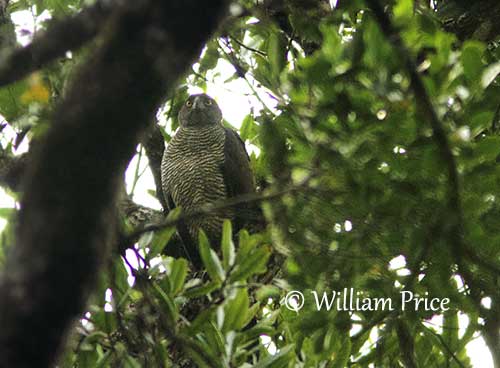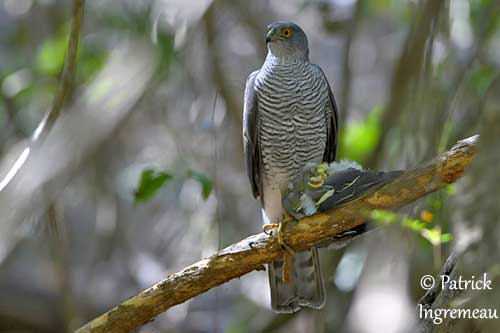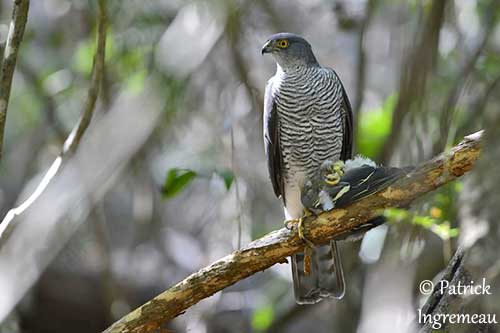
The Henst’s Goshawk hunts from perches inside the canopy and moves from branch to branch with short flights. It may catch some chickens in villages, but usually, it does not hunt in open habitats. It may sometimes pursue a prey on the ground, or flies low while searching for prey, but it also flies fast through the forest.
The prey is killed on the ground or carried up to a branch according to the size. Largest prey are decapitated before to be brought to the nest.
At the beginning of the breeding season, the pair forms on nest territory. Both birds usually give loud advertising calls. They visit an old nest some days later, or prospect for a new site if the old nest is destroyed.
The copulation occurs after the nest building. The birds are very aggressive during the breeding season, and attack intruders approaching the nest placed in a high tree fork.
The Henst’s Goshawk is resident in its range, but the juveniles disperse from the breeding areas.
It has short, rounded wings and rather long tail. It soars above the forest canopy during the breeding season, whereas in non-breeding period, it is very secretive and perches silently, although at any time, it circles high in the air while calling loudly.
REPRODUCTION OF THIS SPECIES:
The breeding season starts in July after pair formation. The laying occurs between September and November.
The Henst’s Goshawk builds a large stick nest lined with green leaves. It is placed in high tree fork, about 17-22 metres above the ground. Both adults build the nest with material collected within 50 metres from the nest-site. They may reuse an old nest. Several pairs may nest 7-12 kilometres apart.
The female lays 2-3 white eggs and performs most of incubation with little help from the male. However, it feeds her during the incubation that lasts 39-40 days.
At hatching, the chicks have white down. The female broods and feeds them, but the male provides all the food during the first two weeks. The young fledge 43-47 days after hatching, but they remain close to the nest-site until they are 70 days old. They are fed in the nest until the 65th day, but they are independent only at three months old.
The chicks are attacked at nest by other raptors, and are vulnerable to bad weather conditions.
PROTECTION / THREATS / STATUS:
The Henst’s Goshawk is threatened by deforestation and human disturbance. It is rare and sparsely distributed. However, it occurs in several protected areas.
The small population is estimated to number 1,000/3,000 individuals, equating roughly to 670/2,000 mature individuals. This population is declining.
The Henst’s Goshawk is currently listed as Near Threatened.
Fr: Autour de Henst
Ang: Henst's Goshawk
All: Madagaskarhabicht
Esp: Azor Malgache
Ita: Astore di Henst
Nd: Madagaskarhavik
Sd: madagaskarduvhök
Mal: Firasabe, hindry, Rehila, Rehito
Photographers:
Patrick Ingremeau
TAMANDUA
William Price
PBase-tereksandpiper & Flickr William Price
Text by Nicole Bouglouan
Sources :
HANDBOOK OF THE BIRDS OF THE WORLD Vol 2 by Josep del Hoyo-Andrew Elliot-Jordi Sargatal - Lynx Edicions - ISBN: 8487334156
BIRDS OF PREY OF AFRICA AND ITS ISLANDS by Alan and Meg Kemp - Struik Publishers - ISBN: 1770073698
The Birds of Africa: Volume VIII: The Malagasy Region: Madagascar, Seychelles, Comoros, Mascarenes - Par Roger Safford, Frank Hawkins – ISBN: 1408190494, 9781408190494- Editeur: A&C Black, 2013
Birds of Madagascar and the Indian Ocean Islands Par Roger Safford, Adrian Skerrett, Frank Hawkins – ISBN: 1472924118, 9781472924117- Editeur: Bloomsbury Publishing, 2015
Global Raptor Information Network - Working to Conserve Birds of Prey in nature
Henst’s Goshawk
Accipiter henstii
Accipitriformes Order – Accipitridae Family
INTRODUCTION:
The Henst’s Goshawk is endemic to Madagascar where it occurs in forest habitats in N, W and E of the island. It spends much time perched within trees and it is often difficult to find it.
It feeds on medium-sized birds and small mammals, and hunts from perch or while flying low in search of prey.
The Henst’s Goshawk is affected by deforestation and human disturbance. It is sparsely distributed on Madagascar and the small population is declining. It is currently listed as Near Threatened.


DESCRIPTION OF THE BIRD:
Biometrics:
Length: 52-62 cm
Wingspan: 86-100 cm
Weight: M: 609 g – F: 960-1140 g
The Henst’s Goshawk adult has brownish-grey upperparts with hidden white bases to nape and hindneck feathers. The tail feathers are barred dark and pale brown, with broad, dark brown terminal bar. The upperwing is dark brown with white markings on inner webs.
On the underparts, chin and throat to belly, flanks and thighs are white with narrow, dark bars and spots. On the underwing, coverts and axillaries are barred whitish and dark brown. The flight-feathers are greyish with dark tips and dark brown barring on primaries.
The head is brownish-grey too, but we can see a pale stripe above the eye. Lores, cheeks and ear-coverts are slightly paler than crown.
The hooked bill is black, becoming bluish towards the base. The cere is bluish, but mostly yellow around the nostrils. The eyes are yellow. Legs and feet are yellow to greenish yellow.
Male and female have similar plumage, but the female is larger than male, and she has more pronounced barring on undertail feathers and primaries.
The Henst’s Goshawk is very similar to Northern Goshawk (A. gentilis), but it has yellow eyes at all ages.
The juvenile is browner with dark brown, scaled upperparts. Crown and hindneck are streaked cinnamon, and rest of upperparts show pale buff fringes to feathers. The barring on tail is more conspicuous and there is a narrow, white terminal band.
On the underparts, chin and throat are buffy-white with narrow, dark brown streaking. The breast is cinnamon-buff with dark spotting, and rest of underparts is whitish with large brown spots.
RANGE:
The Henst’s Goshawk is widespread in forest habitat in E, W and N Madagascar, and scarce or rather absent in the spiny forest of SW, and rare on central plateau.
HABITAT:
The Henst’s Goshawk frequents the primary rainforest, but it can be found in dry-deciduous forest too. It may occur occasionally in secondary woodland and Eucalyptus plantations. It is usually below 1000 metres, but occasionally up to 1900 metres of elevation.
CALLS AND SONGS: SOUNDS BY XENO-CANTO
The Henst’s Goshawk gives clear, loud, high-pitched “peer” or “wheer” repeated every 2-10 seconds. It utters a longer sequence “peer-peer-peer-peer-peer…” in territorial behaviour. This powerful call is given during 3-20 seconds and often while flying.
During the breeding season, a well-audible “kow-kow-kow-kow-kow” can be heard at a distance in forest. This raptor is noisy around the nest where it gives high, cackling calls and loud, piercing screams.
The Henst’s Goshawk often calls from perch or in flight, sometimes at high elevation. It is less vocal outside breeding season.
BEHAVIOUR IN THE WILD:
The Henst’s Goshawk feeds on medium-sized birds including forest birds and poultry, small mammals (lemurs, hedgehogs and others) and some reptiles.
The main bird prey is the Blue Coua with 52% of total. But other birds such as other Coua species, coucals, doves and guineafowls are also taken.
The prey varies with season and sex of the hunting bird. The male takes mainly birds, whereas the female prefers mammals.
